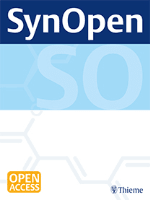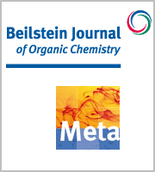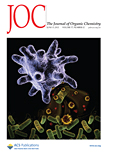
ADVANCED SYNTHESIS & CATALYSIS
Scope & Guideline
Unleashing potential through cutting-edge methodologies.
Introduction
Aims and Scopes
- Catalytic Methodologies:
The journal emphasizes the development of innovative catalytic methodologies, including transition metal catalysis, organocatalysis, and biocatalysis, which facilitate new synthetic routes. - Synthetic Applications:
Research articles often showcase synthetic applications of developed methodologies, demonstrating their utility in the synthesis of complex organic molecules, pharmaceuticals, and materials. - Mechanistic Insights:
The journal encourages studies that provide mechanistic insights into catalytic processes, helping to elucidate reaction pathways and improve catalytic efficiency. - Sustainability in Synthesis:
A growing focus on sustainable practices in organic synthesis is evident, with contributions addressing the use of renewable resources, reduction of waste, and development of green chemistry techniques. - Cross-Coupling Reactions:
Cross-coupling methodologies, especially those involving novel reagents and conditions, are a core area of interest, reflecting ongoing advancements in the field. - Electrochemical and Photochemical Reactions:
Recent publications highlight the increasing importance of electrochemical and photochemical approaches in organic synthesis, showcasing innovative applications and new reaction types.
Trending and Emerging
- Photoredox and Electrochemical Catalysis:
There is a marked increase in studies focused on photoredox and electrochemical catalysis, which highlight the potential of light and electricity to drive organic transformations. - Sustainable and Green Chemistry:
Research emphasizing sustainable methods, including the use of renewable resources and waste reduction practices, is gaining traction, aligning with global sustainability initiatives. - Asymmetric Synthesis:
The journal has seen a rise in contributions dedicated to asymmetric synthesis, particularly using novel chiral catalysts that enhance enantioselectivity in complex molecule construction. - Multicomponent Reactions:
The popularity of multicomponent reactions is on the rise, showcasing their efficiency in synthesizing complex molecules in fewer steps. - Machine Learning and Artificial Intelligence in Catalysis:
Emerging studies integrating machine learning and AI to predict reaction outcomes and optimize catalytic processes are becoming more prevalent, reflecting advancements in computational chemistry. - Diversity-Oriented Synthesis:
Research focused on diversity-oriented synthesis is trending, with an aim to create libraries of compounds with potential biological activity, reflecting the journal's commitment to pharmaceutical applications.
Declining or Waning
- Traditional Organic Synthesis:
There is a noticeable decline in publications focused on traditional organic synthesis methods, as researchers increasingly gravitate toward more modern and efficient catalytic techniques. - Conventional Solvents in Reactions:
Research utilizing conventional solvents is becoming less common, with a shift towards solvent-free or environmentally friendly solvent systems, aligning with the journal's sustainability goals. - Non-Catalytic Reactions:
The frequency of studies on non-catalytic reactions appears to be decreasing, as the journal prioritizes catalytic strategies that offer enhanced efficiency and selectivity. - Inorganic Catalysis:
While still relevant, the focus on inorganic catalysis is diminishing relative to the growing interest in organometallic and organocatalytic methods. - Classical Reaction Mechanisms:
The exploration of classical reaction mechanisms is less prevalent, as contemporary studies favor innovative, complex mechanisms that provide new insights into catalysis.
Similar Journals

ChemCatChem
Pioneering Insights in Inorganic and Organic Chemistry.ChemCatChem is a leading international journal published by WILEY-V C H VERLAG GMBH that has been making significant contributions to the fields of catalysis, inorganic and organic chemistry, as well as physical and theoretical chemistry since its inception in 2009. With an established reputation for excellence, this journal holds commendable rankings in various categories, including Q1 in Inorganic Chemistry and Q1 in Organic Chemistry, demonstrating its pivotal role in advancing scientific knowledge and innovation. Notably, it has achieved a high Scopus ranking, securing 10th place out of 79 in Inorganic Chemistry, among others, showcasing its influence and quality. Although open access options are not available, the journal offers cutting-edge research articles, reviews, and insights that are vital for researchers, professionals, and students aiming to stay at the forefront of chemical science. With its address rooted in Weinheim, Germany, and convergence projected to continue until 2024, ChemCatChem remains a dynamic platform for disseminating vital advancements within the chemical community.

EUROPEAN JOURNAL OF ORGANIC CHEMISTRY
Advancing the Frontiers of Organic ChemistryThe EUROPEAN JOURNAL OF ORGANIC CHEMISTRY (ISSN: 1434-193X; E-ISSN: 1099-0690), published by WILEY-V C H VERLAG GMBH in Germany, stands as a crucial platform for disseminating innovative research in the fields of organic, physical, and theoretical chemistry. With its inception dating back to 1998 and converging expertise until 2024, this esteemed journal has achieved a notable reputation, earning a Q2 rank in both Organic Chemistry and Physical and Theoretical Chemistry categories as of 2023, indicating its vital contribution to the academic community. Researchers and professionals will benefit from its rigorous peer-reviewed articles, which foster advancement in chemical sciences, while students can leverage its wealth of knowledge to enhance their learning. Although currently not an open-access journal, the content produced is invaluable for those looking to stay at the forefront of chemical research.

Asian Journal of Organic Chemistry
Inspiring the next generation of organic chemistry leaders.Asian Journal of Organic Chemistry, published by WILEY-V C H VERLAG GMBH, stands as a pivotal platform in the realm of organic chemistry, catering to researchers and professionals eager to share their contributions to the field. With an ISSN of 2193-5807 and E-ISSN of 2193-5815, this journal spans a commendable convergence from 2012 to 2024, featuring a notable impact factor highlighted by its Q2 ranking in the 2023 Organic Chemistry category. Positioned at rank #94 out of 211 in Scopus, the journal emphasizes the importance of quality research and innovation in organic chemistry. The lack of open access enhances the journal's selectivity, ensuring only the most rigorous and impactful studies are published. Serving as a vital resource for scholars, students, and practitioners alike, the Asian Journal of Organic Chemistry fosters the dissemination of knowledge, advances academic dialogue, and reinforces the pivotal role of organic chemistry in scientific advancement.

Green Synthesis and Catalysis
Transforming Biotechnology with Sustainable SynthesisGreen Synthesis and Catalysis is a pioneering Open Access journal dedicated to advancing the fields of biotechnology and catalysis, published by KEAI PUBLISHING LTD since 2020. With an impressive Q1 ranking in both Biotechnology and Catalysis and notable Scopus rankings placing it in the top echelons of its categories, this journal serves as a critical platform for researchers and professionals dedicated to innovative and sustainable chemical practices. The journal addresses the pressing need for environmentally-friendly synthesis methods and efficient catalytic processes that align with global sustainability goals. Based in Beijing, China, it offers a wealth of peer-reviewed articles, reviews, and cutting-edge research focusing on green technologies and practices. Academics and practitioners alike can benefit from the journal's wide-ranging scope that promises to push the boundaries of current scientific understanding and application. Engage with the latest discoveries by accessing the journal’s enriching content online, and contribute to the transformative dialogue surrounding sustainable synthesis and catalytic innovation.

SynOpen
Catalyzing Ideas, Enriching ResearchSynOpen is an esteemed open-access journal published by GEORG THIEME VERLAG KG, based in Germany, dedicated to advancing the fields of Biomaterials, Catalysis, Materials Science, and Organic Chemistry. Since its inception in 2017, the journal has established itself as a vital platform for researchers wishing to disseminate their findings in a rapidly evolving scientific landscape, earning a commendable Q2 ranking in Materials Science (miscellaneous) and Q3 in other key categories for 2023. With an increasing impact on its disciplines, SynOpen aims to foster interdisciplinary collaboration and innovation by providing unrestricted access to high-quality research, thus promoting a broader reach and visibility for authors. Scholars, professionals, and students alike can benefit from the comprehensive range of topics covered, as the journal's commitment to presenting cutting-edge studies and methodologies positions it as a crucial resource for contemporary scientific inquiry.

JOURNAL OF SYNTHETIC ORGANIC CHEMISTRY JAPAN
Pioneering research in the heart of organic synthesis.JOURNAL OF SYNTHETIC ORGANIC CHEMISTRY JAPAN, published by the SOCIETY OF SYNTHETIC ORGANIC CHEMISTRY, JAPAN, is an esteemed publication specializing in the dynamic field of organic chemistry. With a rich history dating back to 1944, this journal aims to disseminate pivotal research findings and innovative methodologies in synthetic organic chemistry, fostering collaboration and knowledge exchange among researchers and professionals. Although it currently holds a modest ranking in the Q4 quartile for organic chemistry, its commitment to advancing the discipline remains steadfast. The journal primarily caters to scholars and students seeking to delve deeper into organic synthesis, highlighting original articles, reviews, and methodological studies. While access to the journal is not open, its contributions to the field are essential for anyone invested in understanding the complexities of organic chemistry. We invite you to explore the journal's offerings and enhance your expertise in synthetic organic processes.

ARKIVOC
Innovating Knowledge in Organic Chemistry Since 2000ARKIVOC is an esteemed open-access journal dedicated to the field of Organic Chemistry, published by ARKAT USA INC. Since its inception in 2000, ARKIVOC has aimed to disseminate high-quality research and advancements in organic chemistry, fostering an international exchange of knowledge within this ever-evolving discipline. With its ISSN 1551-7004 and E-ISSN 1551-7012, the journal is committed to providing accessible content free of charge to researchers, students, and professionals around the globe. Although currently categorized in the fourth quartile of Organic Chemistry with a Scopus rank of #188 out of 211, ARKIVOC continues to encourage the publication of innovative works and critical reviews that highlight emerging trends and methodologies in organic synthesis, reaction mechanisms, and material sciences. Its open-access model since 2000 ensures that valuable contributions to scientific knowledge are widely available, promoting collaboration and discovery. The journal is based in the United States, with its editorial office located at the University of Florida, under the guidance of prominent chemists. ARKIVOC provides an essential platform for those deeply engaged in organic chemistry research, supporting the advancement of science for future generations.

Beilstein Journal of Organic Chemistry
Connecting researchers to shape the future of organic chemistry.The Beilstein Journal of Organic Chemistry, published by the renowned BEILSTEIN-INSTITUT, stands as a pivotal platform for advancing the field of organic chemistry since its inception in 2005. With its commitment to Open Access publishing, this journal enables global readership and collaboration, fostering the dissemination of high-quality research. Operating from Germany, the journal has carved out a significant reputation, currently holding a Q2 ranking in the Organic Chemistry category, with impressive Scopus rankings placing it at #91 out of 211 in the field, achieving a 57th percentile. The Beilstein Journal is dedicated to publishing cutting-edge findings that span the breadth of organic chemistry, including synthetic methodologies, catalysis, and material sciences, making it an essential resource for researchers, professionals, and students looking to stay at the forefront of organic chemistry advancements. With a vision to enhance collaboration and knowledge sharing within the scientific community, the journal plays a vital role in shaping the future of organic chemistry research.

JOURNAL OF ORGANIC CHEMISTRY
Elevating Research Standards in Organic ChemistryJournal of Organic Chemistry, published by the American Chemical Society, is a prestigious peer-reviewed journal dedicated to advancing the field of organic chemistry. With an ISSN of 0022-3263 and an E-ISSN of 1520-6904, this journal has established itself as a key platform for disseminating high-quality research since its inception in 1936. Residing in the Q2 category for Organic Chemistry as of 2023, it ranks #64 out of 211 in Scopus, positioning itself within the top 69th percentile of its field. Researchers and professionals can access vital findings and innovative methodologies that drive the understanding and application of organic chemical principles. Although the journal is not open access, it remains a crucial resource in academia and industry, contributing significantly to the scientific community's knowledge base. For detailed insights and cutting-edge research, the journal continues to be an essential read for those engaged in the dynamic and evolving landscape of organic chemistry.

CCS Chemistry
Transforming Ideas into Impactful Chemistry ResearchCCS Chemistry, published by the esteemed Chinese Chemical Society, is a leading open-access journal dedicated to advancing the field of chemistry. Since its inception in 2019, the journal has rapidly gained recognition, achieving a remarkable impact factor that places it in the prestigious Q1 category in Chemistry (Miscellaneous) as of 2023. With a Scopus ranking of #41 out of 408 in General Chemistry, CCS Chemistry represents the top 10th percentile in its category, reflecting its commitment to high-quality research and innovation. The journal serves as a vital platform for researchers and professionals to share their findings, showcase cutting-edge methodologies, and engage with the latest developments in various chemistry subfields. Accessible to a global audience, CCS Chemistry ensures that groundbreaking research is available without barriers, making it an indispensable resource for students and academics aiming to stay at the forefront of chemical sciences. For further details, submissions, and access to published articles, please visit the journal's website.